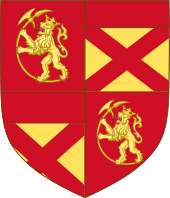Isabel Bruce
| Isabel Bruce | |
|---|---|
Bruce | |
| Father | Robert de Brus, 6th Lord of Annandale |
| Mother | Marjorie, Countess of Carrick |
Isabel Bruce (Isabella de Brus or Isobail a Brus, or Isabella Robertsdotter Brus) (c. 1272–1358) was
Background

Isabel was born in Carrick, Scotland. Her parents were Robert de Brus, 6th Lord of Annandale and Marjorie, Countess of Carrick. Her brothers included Robert the Bruce, future King of Scots, and Edward Bruce who would be High King of Ireland briefly. In 1293 at the age of 21, she traveled to Norway with her father and was married at Bergen to King Eric. Her dowry for the marriage was recorded at the time by Norwegian nobleman Audun Hugleiksson who noted she brought: precious clothes, 2 golden boiler, 24 silver plate, 4 silver salt cellars and 12 two-handled soup bowls (scyphus) to the marriage. [2] [3]
Isabel was king Erik's second wife, he having previously been married to the daughter of King Alexander III of Scotland, Margaret of Scotland, who died in childbirth in 1283. Upon the death of King Alexander three years later, his granddaughter, Eric's daughter Margaret, Maid of Norway became heir to the throne of Scotland. King Eric arranged the marriage of his daughter to the English King Edward I's son Edward, which became moot upon the child's death in 1290. The death of Queen Margaret left Scotland without a monarch, and at the mercy of Edward I of England. [4]
Soon,
Activity
Isabel was widowed, at age 26, at the death of King Eric in 1299. Erik was succeeded by his brother, King
She did not return to Scotland, but lived in
References
- ^ "Isabella Bruce". • Store norske leksikon. Retrieved 29 October 2015.
- ^ Narve Bjørgo. "Eirik 2 Magnusson, Konge". Norsk biografisk leksikon. Retrieved 29 October 2015.
- ^ Knut Helle. "Audun Hugleiksson "Hestakorn"". Norsk biografisk leksikon. Retrieved 29 October 2015.
- ^ Narve Bjørgo. "Margrete Eiriksdotter, Prinsesse og Dronning". Norsk biografisk leksikon. Retrieved 29 October 2015.
- ISBN 9780748620227
- ^ Anna Elisa Tryti. "Arne Sigurdsson, Biskop". Norsk biografisk leksikon. Retrieved 29 October 2015.
- ^ Randi Wærdahl. "Isabella Bruce, Dronning". Norsk biografisk leksikon. Retrieved 29 October 2015.
Other sources
- Blakely, Ruth Margaret (2005) The Brus Family in England and Scotland, 1100-1295 (Boydell Press) ISBN 978-1-84383-152-5
- Penman, Michael (2014) Robert the Bruce: King of the Scots (Yale University Press) ISBN 978-0-30014-872-5
